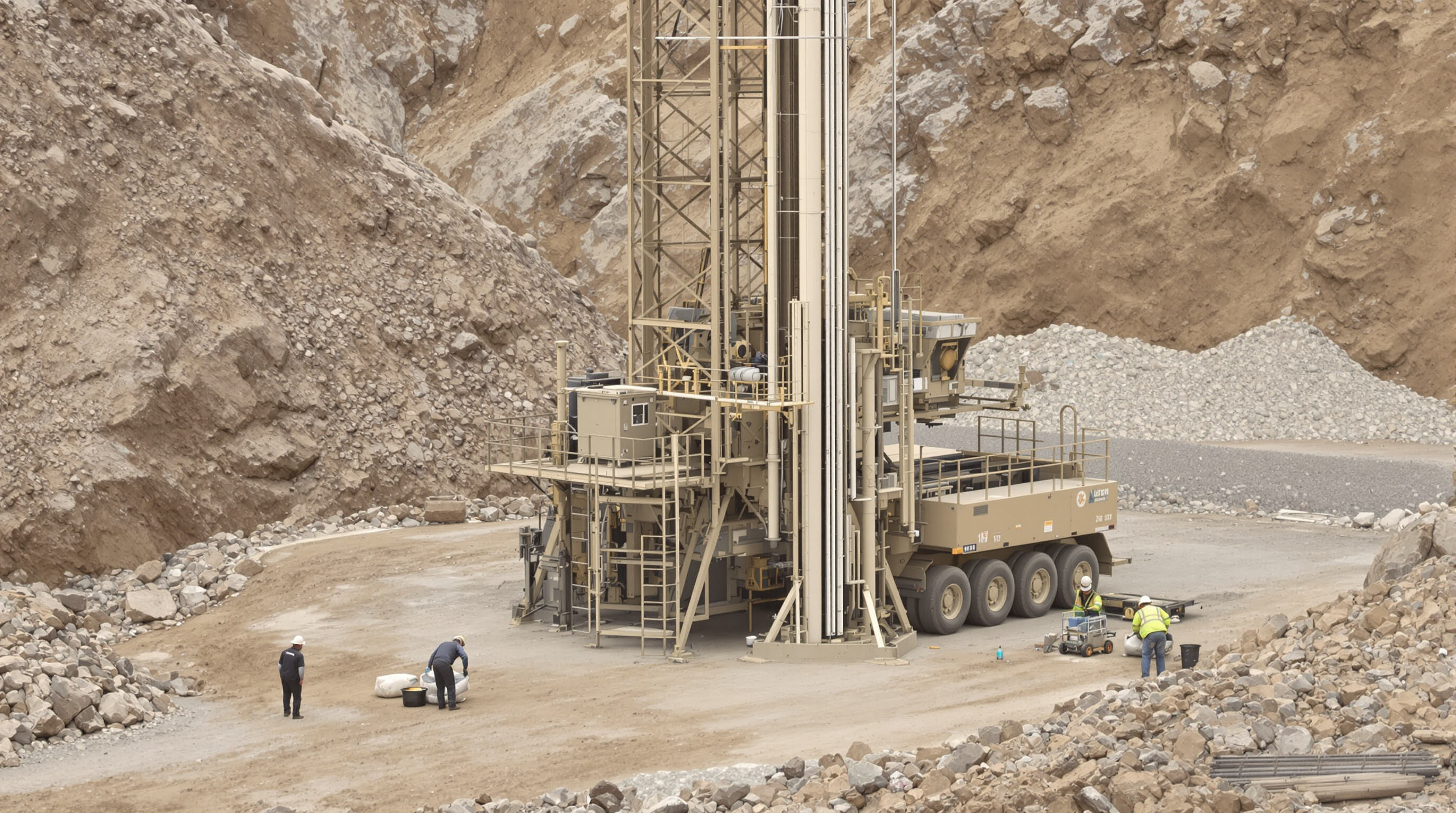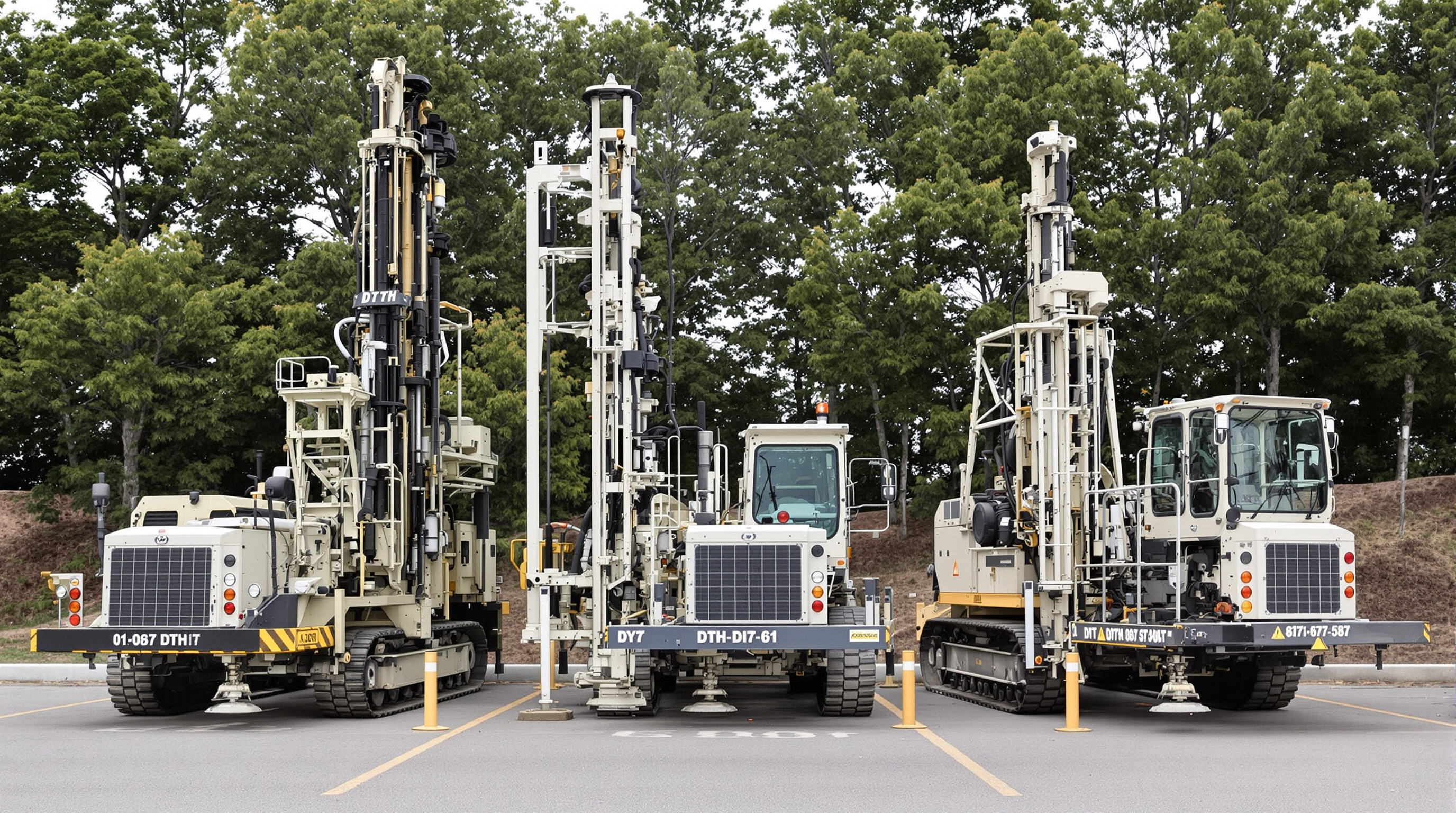Construction Drilling: Balancing Mobility, Precision, and Hole Size
In city building work, portable DTH drill rigs with bits ranging from 4 to 8 inches strike just the right mix between being able to move around tight spots and getting accurate results. Weighing under ten tons, these machines work well even when space is limited, keeping position errors within about two centimeters while they tackle tasks like driving foundation piles into ground or installing soil anchors. The smaller size means less money spent on preparing construction sites too. A recent look at infrastructure efficiency showed that using these rigs instead of big mining machinery can cut site prep expenses anywhere from 18% to as much as 25%. That makes them pretty attractive for urban development where every square meter counts.
Mining Applications: High-Capacity DTH Drill Rigs for Deep, Continuous Drilling

The mining industry requires DTH rigs that can handle drilling depths between 200 to over 300 meters while creating holes ranging from 8 to 12 inches in diameter. When it comes to rotary DTH systems, those powered by compressors in the 30 to 40 kW range typically maintain penetration speeds around 25 to 30 meters per hour when working through tough rock types such as iron ore deposits and granite formations. Looking at recent industry data from last year's productivity studies, we see something interesting happening with modular rig setups. These configurations apparently reduced equipment downtime by nearly 40 percent in copper mining operations simply because parts could be swapped out much quicker than traditional methods allowed.
Water Well Projects: Optimizing Efficiency with Reliable DTH Hammer Systems
In water well drilling, DTH hammer systems are optimized for bit longevity in mixed sedimentary layers, with carbide button bits lasting 300–500 hours. Dual-wall reverse circulation setups achieve 95% sample recovery in aquifer mapping. Field tests show 4–6" diameter holes drilled to 150m depths complete 22% faster than with cable tool rigs.
Comparing Penetration Rates, Bit Life, and Cost Efficiency Across Industries

Performance varies significantly across sectors, as shown in the 2024 Drilling Application Report:
| Industry | Avg. Penetration Rate | Bit Life (Hours) | Cost per Meter ($) |
|---|---|---|---|
| Construction | 15–20 m/hr | 200–300 | 12.50–18.00 |
| Mining | 25–35 m/hr | 150–220 | 9.80–14.20 |
| Water Well | 10–15 m/hr | 350–500 | 16.75–22.40 |
Mining rigs emphasize speed, accepting shorter bit life, while water well systems prioritize durability in abrasive conditions despite slower rates.
Assess Rock Hardness and Ground Conditions to Optimize DTH Drill Rig Performance
Evaluating Geological Formations: Hardness, Abrasiveness, and Fracture Zones
Begin DTH rig selection by assessing rock hardness on the Mohs scale and abrasiveness. Granite (6–7 Mohs) requires high-impact hammers, while abrasive sandstone accelerates bit wear by 30% compared to uniform formations. In fractured zones, smaller bit diameters (4–6 inches) reduce deviation risks. Use core samples or ground-penetrating radar to evaluate:
- Compressive strength: Drilling in 150+ MPa basalt halves penetration rates compared to 80 MPa limestone
- Abrasion index: Quartz-rich formations increase bit replacement costs by $1,200 per project
- Fracture density: Heavily fractured ground requires low RPM (80–100) to prevent collapse
Matching DTH Hammer and Bit Durability to Challenging Rock Conditions
For hard, compact rock, use hammers delivering 500–800 blows per minute (BPM) and tungsten carbide bits with 5/8" button spacing in abrasive conditions. In mixed geology like marble and shale, focus on:
- Seal protection: Dual-seal hammers extend service life by 200 hours by blocking abrasive particles
- Impact energy control: 30–40 kW hammers balance penetration (8–12 m/hr) with bit preservation
- Flushing efficiency: 350 CFM air systems clear cuttings 40% faster in clay-heavy strata
| Hardness Category | Ideal Bit Face Design | Hammer Pressure |
|---|---|---|
| 40-80 MPa (Limestone) | Convex | 18-22 bar |
| 80-150 MPa (Granite) | Flat | 24-28 bar |
| 150+ MPa (Quartzite) | Concave | 30+ bar |
Field Testing and Site Analysis for Informed Drill Rig and Bit Selection
Conduct a 48-hour trial with multiple bit types before full deployment—projects using this method reduced bit replacement costs by 33% in conglomerate formations. Key verification steps include:
- Comparing actual vs. projected penetration rates (±15% tolerance)
- Monitoring hammer temperature spikes above 140°F, indicating poor bit match
- Analyzing cuttings to confirm optimal air pressure
Teams combining digital terrain mapping with on-site testing achieve 92% first-pass hole accuracy, significantly outperforming untested sites (68%) based on 2023 industry studies.
Choose the Right Drill Bit Type and Design for Maximum Drilling Efficiency
Common DTH Drill Bit Types: PDC, Diamond Core, and Tungsten Carbide for Varied Formations
Bit selection directly impacts efficiency across rock types. Polycrystalline diamond compact (PDC) bits outperform standard carbide in homogeneous limestone, achieving 30% faster penetration in medium-hard rock. Tungsten carbide button bits resist wear in abrasive granite and quartzite, while diamond core bits deliver precise sampling for geotechnical work.
PDC and DTH Hammer Bits for High-Efficiency Performance in Hard Rock Drilling
PDC-DTH hybrid systems combine synthetic diamond shearing with pneumatic hammer action, reaching up to 15 m/hr in basalt (2023 International Drilling Report). In volcanic rock, these hybrids reduce bit replacements by 40% versus traditional carbide designs.
Diamond Core Bits for Geotechnical Sampling and Precision Exploration
Diamond-impregnated core bits meet ASTM D2113 standards, capturing intact rock samples with 98% accuracy—essential for mineral and stability assessments. Their thin-kerf design minimizes formation disturbance during 150–300 mm borehole drilling.
Large-Diameter Boring Bits for Piling, Shafts, and Foundation Work
Bits ranging from 600–1,200 mm enable rapid excavation for caisson foundations, maintaining less than 2% vertical deviation. Cross-flow designs improve debris removal by 50% in clay-rich soils, reducing operational delays.
Bit Face Geometry: Flat, Convex, and Concave Designs for Specific Ground Conditions
- Flat-face geometry enhances stability in fractured shale
- Convex profiles improve centering in soft-to-medium sandstone
- Concave designs optimize cuttings evacuation in water-saturated formations
Field trials confirm that proper geometry selection boosts drilling speed by 25% and extends bit life by 60–80 hours in mixed lithologies.
Determine Optimal Drilling Depth and Hole Diameter Requirements
Planning for depth and diameter: Key factors in DTH drill rig selection
Selecting the right DTH rig requires aligning depth and diameter capabilities with project goals. While geothermal projects may exceed 1,000 meters and require specialized configurations, civil engineering applications often prioritize hole diameter over extreme depth. For instance, foundation piling typically requires 150–300 mm diameters, whereas mineral exploration usually stays under 76 mm.
Aligning bit size and rig capability with project-specific well or borehole needs
When components don't match properly, efficiency drops significantly in rocks harder than about 200 MPa, sometimes as much as 40 percent. For instance, water well projects that require drilling 12 inch holes through sedimentary layers work best when paired with DTH hammers and air compressors rated between roughly 400 to 500 cubic feet per minute. On the flip side, those blasted out holes in tough granite formations tend to respond better to smaller 5 inch bits combined with high frequency hammering equipment. The bottom line is matching things right matters. Rig torque needs to be at least around 8,000 Newton meters for really dense rock types, while keeping compressor pressure somewhere between 18 and 25 bars based on what actual field conditions show during exploration phases.
Overcoming depth limitations in standard DTH systems with advanced configurations
Most standard down-the-hole drilling rigs struggle to go much beyond around 1,200 meters when working through tough rock formations. But things change when we look at hybrid systems that combine reverse circulation techniques with high pressure air (over 35 bar). These setups have been known to push past the 2,000 meter mark in certain conditions. The industry has seen some interesting advancements recently too. Dual wall drill pipes help cut down on those pesky friction losses during operation. And don't forget about those 10 stage hammers that keep performing even when drilling gets really deep into abrasive rock layers. We've actually run field tests in several Canadian Shield mines and found something remarkable. At depths where traditional equipment just gives up, these new systems are maintaining roughly 85% penetration rates. That kind of performance makes all the difference for mining operations trying to access deeper deposits.
Evaluate Power, Maintenance, and Long-Term Cost Efficiency of DTH Drill Rigs
Balancing Power Output and Fuel Efficiency in Modern DTH Drilling Systems
Modern DTH rigs optimize performance with advanced air compression and automated throttle controls. Units equipped with variable-frequency drives (VFDs) deliver 18–22% fuel savings in hard rock by adjusting rotation and percussion in real time, minimizing energy waste without sacrificing progress.
Proper Maintenance Practices to Extend Bit and Rig Service Life
A structured 3-phase maintenance protocol extends DTH rig lifespan by 40–60% in harsh environments:
- Daily: Clean air filters and check hammer lubrication
- Weekly: Inspect bit wear and shank alignment
- Monthly: Pressure-test hydraulics and replace worn seals
Rigs on this schedule show 35% longer bit life compared to those maintained reactively.
High Initial Cost vs. Long-Term Savings: The Durability and ROI of Premium DTH Rigs
Though premium DTH rigs cost 25–40% more upfront, their return on investment emerges within 12–18 months due to superior durability and efficiency:
| Cost Factor | Standard Rigs | Premium Rigs |
|---|---|---|
| Bits/Hourly Wear | $18-$22 | $9-$12 |
| Downtime Costs | 14% | 6% |
| Relining Frequency | 80 hours | 140 hours |
Mining operations using tier-1 DTH systems achieve a 3:1 ROI over five years through lower replacement costs and consistent performance.
FAQ
What are DTH drill rigs?
DTH (down-the-hole) drill rigs are specialized machinery used for drilling through solid rock, soil, or other materials. They are equipped with hammers and bits to create holes of varying depths and diameters in construction, mining, and water well projects.
What is the advantage of using a modular rig setup in mining?
Modular rig setups allow for quicker replacement of parts, significantly reducing equipment downtime. This makes them particularly useful in mining operations where minimizing downtime is crucial for efficiency.
How does bit selection impact drilling efficiency?
Choosing the correct drill bit type and design significantly affects drilling speed, bit life, and overall efficiency. Different rock formations require specific bit geometries for optimal performance, as well as materials like diamond or tungsten carbide for specific conditions.
What factors should be considered when selecting a DTH rig for a project?
Key factors to consider include rock hardness, ground conditions, desired hole diameter, and required drilling depth. Equipment capabilities such as hammer pressure, bit face design, and air compression systems play essential roles in matching the rig to the project's needs.
Table of Contents
- Construction Drilling: Balancing Mobility, Precision, and Hole Size
- Mining Applications: High-Capacity DTH Drill Rigs for Deep, Continuous Drilling
- Water Well Projects: Optimizing Efficiency with Reliable DTH Hammer Systems
- Comparing Penetration Rates, Bit Life, and Cost Efficiency Across Industries
- Assess Rock Hardness and Ground Conditions to Optimize DTH Drill Rig Performance
-
Choose the Right Drill Bit Type and Design for Maximum Drilling Efficiency
- Common DTH Drill Bit Types: PDC, Diamond Core, and Tungsten Carbide for Varied Formations
- PDC and DTH Hammer Bits for High-Efficiency Performance in Hard Rock Drilling
- Diamond Core Bits for Geotechnical Sampling and Precision Exploration
- Large-Diameter Boring Bits for Piling, Shafts, and Foundation Work
- Bit Face Geometry: Flat, Convex, and Concave Designs for Specific Ground Conditions
- Determine Optimal Drilling Depth and Hole Diameter Requirements
- Evaluate Power, Maintenance, and Long-Term Cost Efficiency of DTH Drill Rigs
- FAQ

